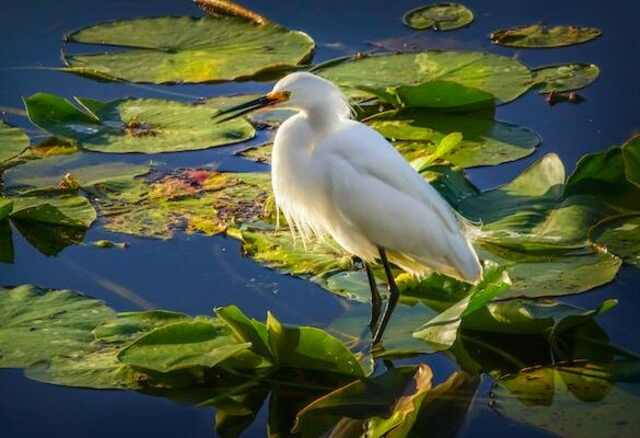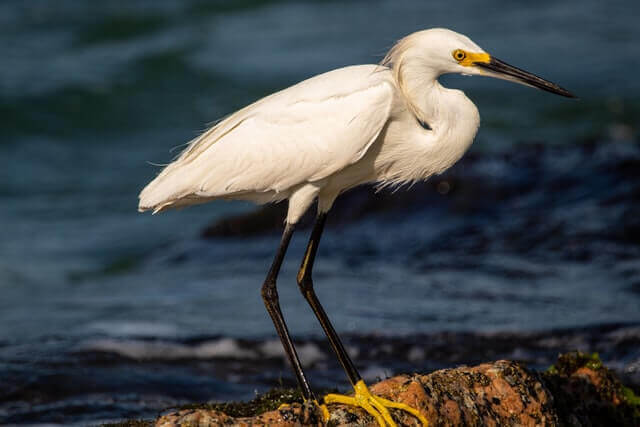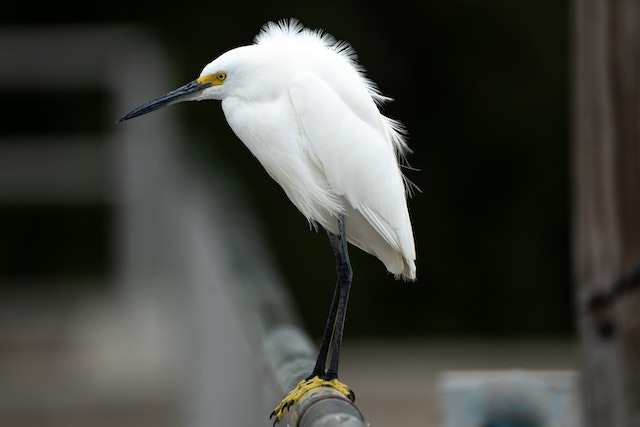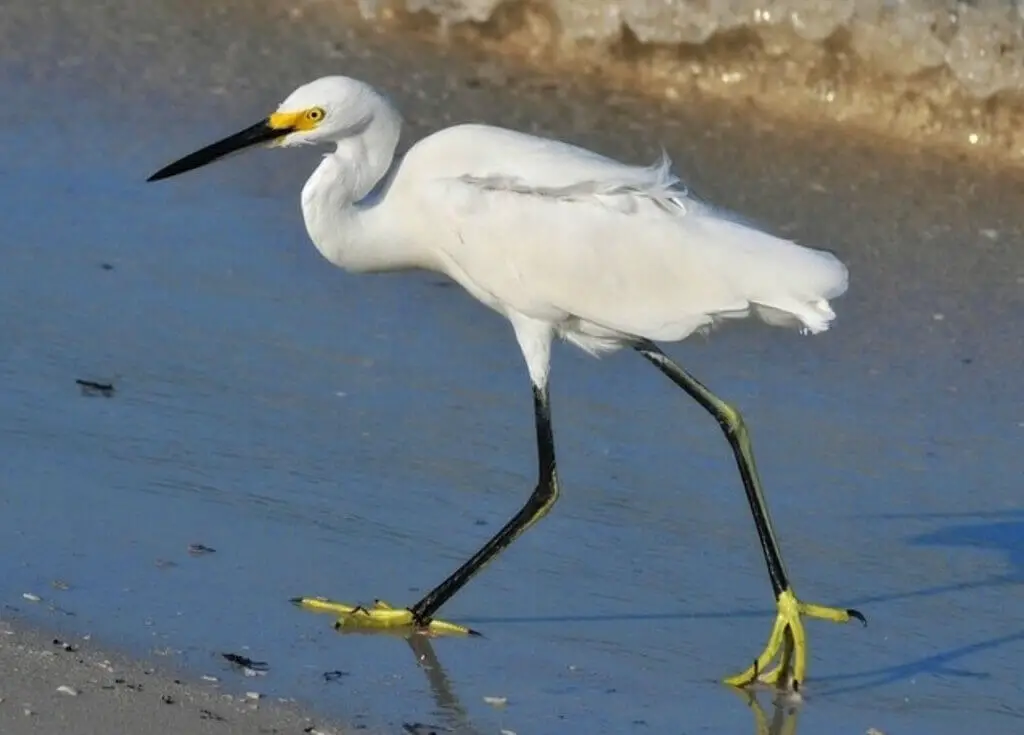Snowy Egrets, with their elegant appearance and intriguing behaviors, captivate the imagination of bird enthusiasts and nature lovers alike.
In this collection of 60 interesting facts about Snowy Egrets, we dive into the lives of these beautiful waders, uncovering their unique characteristics, migratory habits, and the challenges they face in their natural habitats.
From their stunning breeding plumage to their role in ecosystem health, join us on a journey to discover the remarkable world of Snowy Egrets.
Snowy Egret (Overview)

| Characteristics | Description |
|---|---|
| Identification | Adult Snowy Egrets have bright white plumage with tufted crests (aigrettes), a long black bill with a bright yellow patch at the base and around the eye, piercing yellow eyes, black legs, and yellow feet. Immature Snowy Egrets have light green legs. |
| Adult Length | 1.8 – 2.2 feet (22.1-26.0 inches). |
| Adult Weight | 13.1 oz (370 g). |
| Wingspan | 2.9 – 3.3 feet (35-39.5 inches). |
| Taxonomy | Kingdom: Animalia, Phylum: Chordata, Class: Aves, Order: Pelecaniformes, Family: Ardeidae, Genus: Egretta, Species: E. thula, Binomial Name: Egretta thula, Scientific Name: Egretta thula. |
| Range | North America, Central America, South America, and the Caribbean islands. |
| Migration | Snowy Egrets are migratory birds, flying to warmer climates during winter months when temperatures drop below 20 degrees Fahrenheit (-6 degrees Celsius). They migrate to places like Florida and South America. |
| Habitat | Wetlands, ponds, streams, rivers, and estuaries. |
| Diet | Primarily small fish (minnows, catfish), frogs, insects (dragonflies, beetles), crabs, and various invertebrates and crustaceans (crayfish, snails, squid). |
| Global Extent of Occurrence | Approximately 19,845,650.949 square miles (51,400,000 km2). |
| Population | North America Population: Estimated 143,000 individuals. |
| Conservation Status | Listed as Least Concern (Population Increasing). |
| Lifespan | In the Wild: 17 years of age; In Captivity: 22 years of age. |
| Breeding Period | March – April. |
| Incubation Duration | 24–25 days. |
| Nestling Duration | 20–24 days. |
| Clutch Size | 2–6 eggs. |
| Egg Color | Light Blue. |
| Nesting Habits | Snowy Egrets nest in both saltwater and fresh habitats. They construct shallow nests made of sticks and lined with small branches. Nests are typically built on the ground, in shrubs, or in trees up to 30 feet high. Both adults take turns incubating the eggs. Nestlings leave the nest in 19 to 25 days and start hopping from branch to branch, eventually flying at around 30 days. |
Interesting Facts About Snowy Egrets
- The Snowy Egret was first classified by Chilean naturalist Juan Ignacio Molina in 1782 as “Egretta thula”.
- The oldest Snowy Egret ever recorded was 17 years, 7 months old. This bird was banded in 1970, in Colorado, and was later found in 1988 in Mexico.
- Snowy Egrets can cruise at a horizontal speed of around 25 miles per hour or (40 kph).
- The Snowy Egret is much smaller than the great egret. Snowy Egrets measure only 22-26″ inches in length, while the Great Egret measures between 31-41″ inches in length.
- Snowy Egrets are primarily carnivorous (piscivorous), meaning their diet mainly consists of fish. They may occasionally consume other small animals like crustaceans, insects, and amphibians, but fish are their primary food source.
- When breeding season comes around for these birds, males will relentlessly fight each other for females and their territory on lakes and ponds across the U.S.
- Snowy egrets have been known to travel up to 500 miles from their breeding grounds back to their favorite nesting sites.
- It is not uncommon to see a Snowy Egret’s bright yellow feet as they dig for food.
- The Snowy Egret is named after the color of its plumage.
- Snowy Egrets can live as long as 17 years in the wild, and up to 22 years in captivity.
- Snowy Egrets are very aggressive bird and will attack anything it feels is a threat to itself or its nest.
- Snowy egrets are monogamous. The males and females pair up for life, in a practice called “pair bonding.” Pair bonded birds spend most of their time together and usually mate for life.
- Due to their aggression during breeding season. They have been known to attack people that run past their nests, as well as people that approach them at a close range.
- These birds are one of the most abundant throughout Florida, southern Georgia, Alabama, Louisiana, Mississippi and Texas.

- The Snowy Egret’s diet is not limited to fish. They have many foods they eat throughout the year, especially during the summer months when their diet is more diverse.
- The Snowy Egret’s habitat consists of wetlands. It has a large range, which covers over 50 million kilometers in the United States and Canada, but it is protected almost exclusively in Florida, because it has been disappearing at an alarming rate due to development.
- When the breeding season arrives, the males will perform mating dances to attract a female snow egret. These dances can be quite dramatic and seem almost comical at times.
- The snowy egret only remains in the south for approximately 6 months out of the year, before heading up north in late summer for breeding season.
- When these birds come together during their winter migration, they tend to travel in large flocks, especially while crossing bodies of water larger than a lake or a river. They feed together and swim together until they reach their destination.
- The Snowy Egret is often seen in salt marsh habitats, breeding colonies are often near coasts. They are rarely seen inland.
- Snowy Egrets are very social birds and usually travel in groups of 10 or more during non-breeding season.
- Snowy Egret nests are built in trees, but they usually nest on platforms of sticks placed in trees or shrubs. The average clutch size is 2–4 eggs, which are incubated by both parents for 24-25 days until hatching. Both parents also aggressively defend the nest site during this time.
- Snowy Egrets are protected under the Migratory Bird Treaty Act of 1918 which prohibits hunting them or their eggs without a permit. The hunting of Snowy Egrets is banned throughout North America.
- Snowy Egrets are known to be especially vulnerable to oil spills, and at risk of exposure to several types of pollutants including lead, mercury (and its compounds), polychlorinated biphenyls (PCBs) and polycyclic aromatic hydrocarbons (PAHs).
- They were hunted and shot by plume hunters between the years of 1880 to 1910 for their feathers, which were used to decorate women’s hats, and clothing. This led to near extinction of the species in the United States.

- In 1886, Egret plumes were valued at twice the price of gold at $302 per ounce. This value was due to the immense demand for these feathers in the craze of Victorian fashion trends during this time period. With no other material being able to take its place, people paid handsomely for these feathers because they wanted them so badly. These valuable feathers continued to be in high demand until around 1915 when their popularity began to decline with the advent of new materials and fabrications.
- Snowy Egrets are migratory birds, meaning they move seasonally to find suitable habitats and food sources. During the colder winter months, they migrate south to regions with milder climates, and in the spring, they head north to breeding grounds. This migration allows them to avoid harsh winter conditions and take advantage of seasonal food availability.
- Snowy Egrets build their nests in various locations, primarily in trees or on platforms constructed from sticks. These nests are strategically placed near water sources like lakes, rivers, or coastal areas, where the birds can easily find food for themselves and their chicks.
- Both male and female Snowy Egrets actively participate in parental care. They take turns incubating their eggs, ensuring that they remain at the right temperature for successful hatching. After the chicks hatch, both parents continue to provide protection, warmth, and food until the young birds are ready to fledge.
- Snowy Egrets use a range of vocalizations to communicate with each other. These include soft croaks and squawks, which can be used for various purposes such as maintaining contact with their mate, warning of danger, or signaling during courtship.
- During the breeding season, Snowy Egrets undergo a striking transformation in appearance. They develop beautiful plumes on their head, neck, and back, which they display during courtship rituals. These plumes are believed to play a role in attracting potential mates.
- Snowy Egrets are protected under the Migratory Bird Treaty Act of 1918 in North America. This legal protection prohibits hunting, capturing, or harming these birds and their eggs without proper permits, contributing to their conservation and preservation.
- During their winter migration, Snowy Egrets often form large flocks. This behavior offers protection from predators and enhances their foraging efficiency. These flocks can be seen traveling together and foraging in unison.
- Snowy Egrets are commonly found in salt marsh habitats and near coasts. They prefer wetland areas with ample access to water, which provides them with a diverse range of prey species, including fish, crustaceans, and insects.


